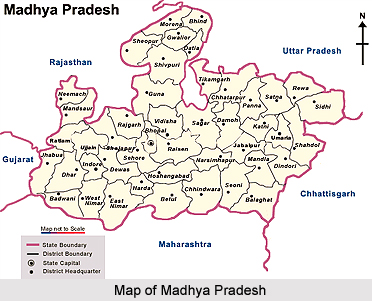 Madhya Pradesh is situated in the heart of India and hence it has been given the name Madhya Pradesh. It is the second largest state by area and sixth largest state by population. The meandering valleys, lush green forests, hills and ravines add to the beauty of the state. The capital of this state is Bhopal.
Madhya Pradesh is situated in the heart of India and hence it has been given the name Madhya Pradesh. It is the second largest state by area and sixth largest state by population. The meandering valleys, lush green forests, hills and ravines add to the beauty of the state. The capital of this state is Bhopal.
History of Madhya Pradesh
The Malwa or Avanti region was inside the state of Madhya Pradesh. The region was dominated by the predecessors of the Bhil tribe, Gond tribe and other tribes. After the decline of the Mughals, the tribes (Gonds) gained control of Malwa. In 1690, the Marathas followed the Mughals. Though the area was under British jurisdiction, the region was administered by the Marathas. After Independence, Malwa was joined with the regions of Indore and Bhopal. On November 1, 1956 it was organised into Madhya Pradesh. A part of Madhya Pradesh has been separated and formed into a new state Chhattisgarh from November 1, 2000.
Geography of Madhya Pradesh
Madhya Pradesh is situated in the centre of India and is surrounded in the south by Maharashtra and Andhra Pradesh, in the north by Uttar Pradesh and Rajasthan, in the east by Bihar and Orissa and on the west by Gujarat. The main rivers flowing through the district are Chambal River, Betwa River, Sindh River, Narmada River, Tapti River, Mahanadi River and Indravati River. Forests cover one third area of the state. The climate is extreme in the north of and is cool and breezy in the central parts and humid in the eastern and southern regions of Madhya Pradesh.
Demography of Madhya Pradesh
The total population of Madhya Pradesh is 7, 25, 97,565 out of which males constitute 3, 76, 12,920 and females 3, 49, 84,645. The state of Madhya Pradesh has the largest tribal concentration in India. The population of Madhya Pradesh constitutes 6% of the total population.
Culture of Madhya Pradesh
Madhya Pradesh is bestowed with a rich historical background and cultural heritage. Culture of Madhya Pradesh is rich and diverse. It can be said that the culture of the state is heavily influenced by the indigenous tribal traditions and customs. The state presents a varied milieu of tribal culture.
Education of Madhya Pradesh
The system of education in Madhya Pradesh is very well developed. The over all school level education at Madhya Pradesh is broadly distinguished into three groups - the primary, middle and high school education. Madhya Pradesh has schools for polytechnics, industrial arts and crafts and music. Moreover, there are 12 state universities.
The schools located at Ujjain and Sagar are the oldest and finest in western region of India because of the quality of education. The twelve state universities of Madhya Pradesh have been successful in contributing quality education system These universities are working towards developing more and more new curriculum for students to help them use their talent in the right medium. In the recent times, Madhya Pradesh education system is diverting towards and laying more stress in developing Mass Media studies, Biotechnology, IT related courses, Multimedia programmes.
Administration of Madhya Pradesh
There are 50 districts in the state of Madhya Pradesh. These districts are grouped into eight divisions. The Governor is the Constitutional head of the state. Preparation, revision and approval of working plans in the state of Madhya Pradesh is looked after by a separate wing headed by an officer of the rank of Chief Conservator of Forests, who is assisted by Conservator of Forests and five Conservators of Forest. A system of village level governance, Gram Swaraj, has been put in place, from January 26, 2001, under which Gram Sabhas have been bestowed with considerable powers for development of villages and welfare activities.
Economy of Madhya Pradesh
About 80 percent of the population of Madhya Pradesh depends on agriculture for its livelihood. The principal crops grown here are rice, wheat, soyabean, and mustard. There are cotton textile mills which also add to the revenue of the state. The important trees which add to the revenue system are Sal, teak, and bamboo. The important minerals found in the state are coal, iron, manganese, bauxite, limestone, diamond, marble, ochre, etc. Diesel engines are manufactured at Indore and attractive pottery and carpets are produced at Gwalior. The state is famous for crafts such a Chanderi sarees, leather and clay toys. There are industries such as dyeing, calico printing and bleaching.
Tourism in Madhya Pradesh
The state of Madhya Pradesh is bestowed with numerous natural locales, pilgrimages, mountains, hills, rivers, and historical places. From nature`s treasure Amarkantak in the extreme east, the queen of Satpura Mountain Range, Pachmarhi in the south, mystical Mandu in the west and to the divine monuments of Chitrakoot, living legend of sculpture are Khajuraho, and historical saga of Gwalior district and Orchha in the north, it is full of places created either by nature or history makers. Besides, wildlife sanctuaries and national parks also attract tourists. The other places of tourist interest are Bandhavgarh National Park, Bhimbetka, Kanha National Park, Maheshwar, Onkareshwar, Orchha, Pachmarhi, Sanchi, Shivpuri district and Ujjain.
Madhya Pradesh has produced great men and women who are held in high esteem due to their great deeds. India`s immortal poet-dramatist Kalidasa belonged to Ujjain and great musician Tansen to Gwalior. Palaeolithic, Mesolithic, Neolithic and Iron Age Cultures have flourished in the state of Madhya Pradesh along the Narmada Valley and other river valleys. Rich archaeological wealth has been unearthed in various parts of the state throwing light on its history.






